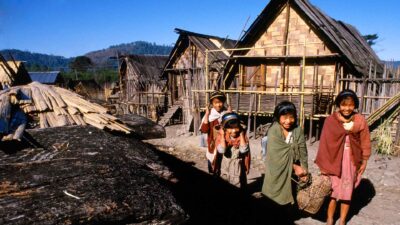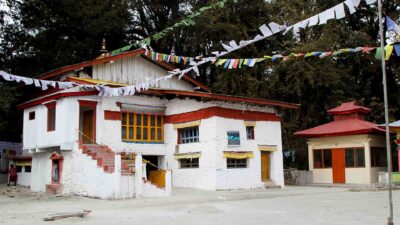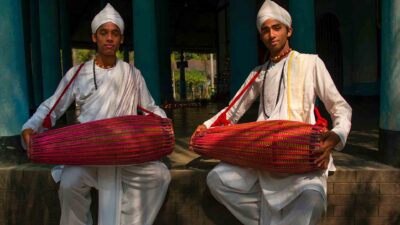A tribal experience in the Assam and Arunachal Pradesh
14 days
If you’re looking for a journey that goes beyond the usual and immerses you in authentic, untouched India — this is it. With us, you’ll step into the world of ancient tribes, mystical landscapes, and traditions that few outsiders have ever seen.
This isn’t just a trip; It’s your chance to meet the the tribal communities of: Idu Mishmi, known for their intricate textiles, animistic rituals and deep spiritual connection to nature; the Adi, famous for their warrior heritage and powerful ceremonial dances; the Apatani, who live in stilted wooden villages, cultivating rice and fish with ingenious sustainable methods, and whose women bear striking tattoos and ornaments as symbols of their culture; and the Mishing, river people of Majuli, masters of weaving and guardians of a peaceful way of life along the Brahmaputra.
You’ll walk through these villages, sit among elders as they share stories of ancestors, watch their rituals and dances come alive just for you, and even try your hand at ancient crafts and weaving yourself. On Majuli Island you’ll meet the monks who preserve centuries-old spiritual traditions and watch them craft ritual masks by hand.
Along the way, you’ll take in the serene bamboo forests of Ziro, the raw wilderness of Kaziranga’s rhinos and elephants, the sacred energy of Kamakhya temple in Guwahati, and magical sunsets over the Brahmaputra — every day delivering something unforgettable.
This itinerary isn’t just about seeing — it’s about experiencing, connecting, and truly understanding one of the most fascinating and least-explored regions of India. You won’t just come home with photos. You’ll come home with stories and emotions you’ll never forget.
JOURNEY OVERVIEW AND PROGRAM DETAILS
1° DAY: ARRIVAL IN KOLKATA
Kolkata
Arrival at Kolkata International Airport and check in at the Hotel. Kolkata, is the capital of the state of West Bengal. Located on the east bank of the Hooghly River, it is the main commercial, cultural and educational center of East India, and its port is the oldest in the country and the only river port. Calcutta was the capital during British colonialism, for this reason preserves in many buildings the architectural style of that period, which contrasts sharply with the degradation of some urban areas and with the more recent and dynamic suburbs and with the inevitable air-conditioned shopping centers. After a short rest, visit the Indian Museum, Victoria Memorial hall, St. John’s Church, and Kali Temple.
Overnight in Kolkata
2° DAY: VISIT OF KOLKATA
Kolkata
In the morning after breakfast, you will have the opportunity discover the cultural heritage of the North of Kolkata, which includes the ancient noble palaces and mansions, the potter’s village in Kumartuli, the lively local shops and the narrow streets and alleys from which the city has evolved in a few centuries. After lunch, visit Missionaries of Charity and take part in feeding and pampering the especially abled Orphan Children, playing and dancing with them. Afterwards visit Mother’s House, the place where Mother Teresa spent most of her life. In the Evening, you will be taken to Iskcon Temple to have Darshan of Evening Arati. Enjoy the Ecstatic Kirtan and dancing in front of the Deities. Evening Dinner Prasadam at Govinda’s Restaurant.
Overnight in Kolkata. (B, D)
3° DAY: ARRIVAL AT DIBRUGARH
Dibrugarh – Roing
Upon your arrival at Dibrugarh Airport, you will be met by one of our representatives who will assist you and transfer you by car to Roing, a small town at the gateway to the Mishmi Hills. The scenic drive of approximately 3–4 hours passes through green landscapes, river valleys and villages before reaching Roing, inhabited by the Idu Mishmi Tribe, known for their distinctive culture and traditions.
Overnight in Roing (B, L, D)
4° DAY: VILLAGE WALKS AND CULTURAL VISITS IN ROING
Roing
After a relaxed breakfast, you will set out on village walks to learn about the fascinating culture and traditions of the Idu Mishmi Tribe, one of the most ancient ethnic groups of Arunachal Pradesh, historically known as skilled hunters, herbalists, and weavers, with a unique animistic belief system. Their intricate textiles, symbolic tattoos, and age-old rituals reflect a deep connection to nature and ancestral wisdom.
Later, visit the RIWATCH Indigenous Museum, part of the Research Institute of World’s Ancient Traditions, Cultures and Heritage. This important NGO works to document, preserve, and promote the knowledge, oral histories, and crafts of Arunachal’s diverse tribal communities, providing a unique window into their cultural heritage through exhibits, photographs, and artifacts.
You will also stop at the local market and the arts and crafts shop, where you can see and purchase traditional handmade items directly from local artisans. In the late afternoon, enjoy the sunset over the picturesque Sally Lake, surrounded by lush forested hills, a serene spot to end the day.
Overnight in Roing (B, L, D)
5° DAY: DRIVE TO PASIGHAT AND VISIT TO ADI TRIBE VILLAGES
Roing – Pasighat
After breakfast, you will travel to Pasighat, a journey of approximately 4–5 hours. Founded by the British in 1911 as a gateway to the Abor Hills, Pasighat lies in the heartland of the powerful Adi Tribe. Here you will visit Adi villages and interact with the tribespeople to gain insight into their rich traditions and way of life, shaped by centuries of resilience and close connection to the land. A traditional war dance performance by the Adi will also be arranged, showcasing their vibrant cultural heritage.
Overnight in Pasighat (B, L, D)
6° DAY: DRIVE TO ZIRO, LAND OF THE APATANI TRIBE
Pasighat – Ziro
After breakfast, you will travel uphill to Ziro, a scenic Himalayan valley located at an altitude of 1,500 meters, a journey of approximately 6–7 hours. Surrounded by evergreen forests, terraced rice fields, and misty mountains, Ziro is home to the Apatani tribe, known for their sustainable farming practices and distinctive cultural traditions. The indigenous Apatani women are particularly renowned for their unique facial tattoos and traditional nose plugs, symbols of identity and heritage. Recognized for its cultural significance, Ziro has been proposed as a UNESCO World Heritage site for its harmonious relationship between people and nature.
Overnight in Ziro (B, L, D)
7° DAY: DISCOVERING APATANI VILLAGES AND TRADITIONS
Ziro
After breakfast, you will spend the day visiting the villages of the Apatani people, such as Hong, Hari, Baro, and Siiro. These villages still preserve their traditional wooden houses built on stilts, compactly arranged as a defense against historical raids from neighboring tribes. At the center of each village, you will see the Lapan, a raised platform that serves as the community’s gathering point for ceremonies and discussions, while tall Babo totem poles stand in front of many houses as symbols of heritage. You will have the opportunity to meet the villagers and learn about their way of life, deeply rooted in respect for nature and community.
Overnight in Ziro (B, L, D)
8° DAY: CULTURAL EXPERIENCES AND PANORAMIC VIEWS IN ZIRO
Ziro
After breakfast, continue your exploration of the Apatani culture. You will visit the terraced rice fields, where their unique wet rice cultivation system combines farming with fish rearing in an environmentally sustainable way. A short hike through bamboo and pine plantations offers a chance to appreciate the valley’s natural surroundings. Later, visit the shrine dedicated to the Donyi Polo religion, the indigenous faith of the Apatani people, and stop at the local market in Hapoli town. From the viewpoint at Hapoli, enjoy a panoramic view over the picturesque Ziro valley. In the afternoon, witness a traditional dance performance by Apatani women in the rice fields, showcasing their cultural richness.
Overnight in Ziro (B, L, D)
9° DAY: DRIVE AND FERRY TO MAJULI, THE WORLD’S LARGEST RIVER ISLAND
Ziro – Majuli
After a leisurely breakfast, you will drive downhill to Dhunabari Ghat, a journey of approximately 4–5 hours, passing through scenic valleys and countryside. From Dhunabari, board the ferry across the Subansiri River to Majuli, the largest river island in the world, renowned for its unique blend of Assamese and tribal culture and its ancient Vaishnavite monasteries. Arrive by afternoon and spend the rest of the day leisurely exploring the vast island and its beautiful rural landscape. The island’s extensive wetlands and lakes also attract a rich variety of birdlife, making it a place of interest for birdwatchers.
Overnight in Majuli (B, L, D)
10° DAY: MONASTERIES, CRAFTS AND TRIBAL LIFE IN MAJULI
Majuli
After breakfast, you will spend the day discovering the cultural and artistic heritage of Majuli. Visit some of the island’s historic 17th-century Assamese monasteries, or sattras, such as Auniati, Kamalabari, and Dakhinpat, founded by the followers of the medieval saint and reformer Srimanta Sankardev. These monasteries preserve the Neo-Vaishnavite philosophy and are centers of traditional art, music, and spiritual drama. Continue to the mask-making center at Samuguri Sattra, where monks craft intricate traditional masks used in Bhaona, the classical dance-dramas depicting scenes from Hindu epics.
Later, visit Salmara potters’ village, unique for its age-old technique of hand-molding earthenware without a potter’s wheel — and try your hand at working with the riverine clay. In the afternoon, explore the villages of the indigenous Mishing tribe, visiting their stilted homes, meeting the villagers, and observing their traditional lifestyle. There will also be an opportunity to try weaving on traditional handlooms. In the evening, enjoy a cultural dance performance by the monks, offering a glimpse into the island’s spiritual and artistic traditions.
Overnight in Majuli (B, L, D)
11° DAY: DRIVE TO KAZIRANGA NATIONAL PARK, LAND OF THE ONE-HORNED RHINO
Majuli – Kaziranga National Park
After a leisurely breakfast, you will drive to Kaziranga National Park, one of India’s premier wildlife destinations and a renowned biodiversity hotspot. Famous for being home to the endangered one-horned rhinoceros, Kaziranga offers a unique ecosystem of grasslands, wetlands, and forests. The area was first declared a protected forest in 1904 by Viceroy Lord Curzon and later designated as a UNESCO World Heritage site for its remarkable conservation of species and habitats.
Overnight in Kaziranga National Park (B, L, D)
12° DAY: SAFARIS AND LOCAL EXPLORATION IN KAZIRANGA NATIONAL PARK
Kaziranga National Park
In the morning, set out on a guided jeep safari in the eastern range of Kaziranga, known for its dense forests and wetlands. This area offers excellent opportunities to spot migratory birds, river dolphins, wild ducks, turtles, and, with some luck, even tigers along the banks of the Brahmaputra River.
Mid-day, visit the local craft shops and the orchid park to appreciate the region’s floral diversity and traditional handicrafts. After lunch, embark on another jeep safari, this time in the western range, where you can encounter wild buffaloes, elephants, swamp deer, sloths , jungle cats, mongooses, and an impressive variety of birds including pelicans, parakeets, fish eagles, and drongos.
Overnight in Kaziranga National Park (B, L, D)
13° DAY: ELEPHANT SAFARI AND DRIVE TO GUWAHATI WITH SIGHTSEEING
Kaziranga National Park – Guwahati
Start the day with a thrilling early morning elephant safari inside Kaziranga National Park, offering a unique perspective of the grasslands and a chance to spot rhinos and other wildlife up close. After breakfast, depart for Guwahati, a journey of approximately 4–5 hours.
Upon arrival in Guwahati, spend the afternoon visiting some of the city’s notable sites. Stop at the revered Kamakhya Temple, one of the most important Shakti shrines in India, and continue to the Navagraha Temple, dedicated to the nine celestial planets. Later, explore local craft shops showcasing Assamese handicrafts. At sunset, enjoy a scenic cruise on the Brahmaputra River, watching the changing colors of the sky over the water.
Overnight in Guwahati (B, L, D)
14° DAY: DEPARTURE FROM GUWAHATI
Guwahati – Airport
After breakfast, transfer to Guwahati Airport in time for your departure flight.
activities
- Explore the colonial and artistic heritage of Kolkata, including the Indian Museum, Victoria Memorial, and North Kolkata’s aristocratic mansions.
- Visit Kumartuli’s potters’ quarter and observe artisans crafting traditional clay idols.
- Spend time at Mother Teresa’s Missionaries of Charity, engaging with orphan children and visiting Mother’s House.
- Experience the evening arati and kirtan at ISKCON Temple, with prasadam dinner at Govinda’s.
- Discover Roing and its surrounding villages, meeting members of the Idu Mishmi tribe and learning about their ancient traditions.
- Visit RIWATCH indigenous museum, Sally Lake, and Roing’s arts and crafts market.
- Travel through the Mishmi Hills and Abor Hills to Pasighat, interacting with the Adi tribe and witnessing a traditional war dance.
- Journey to Ziro Valley, home of the Apatani people, and explore their stilted villages with Lapan platforms and Babo totem poles.
- Observe Apatani women’s unique facial tattoos and nose plugs, symbols of identity and heritage.
- Walk through Apatani terraced rice fields and fish farms, learning about sustainable wet rice cultivation.
- Hike through bamboo and pine plantations in Ziro and visit the shrine of the indigenous Donyi Polo faith.
- Experience a traditional dance performance by Apatani women in the rice fields.
- Cross the Subansiri River to Majuli, the world’s largest river island, and explore its serene rural landscapes.
- Visit Majuli’s 17th-century Neo-Vaishnavite monasteries and attend cultural performances by the monks.
- Watch mask-making at Samuguri Sattra and try your hand at traditional pottery in Salmara village.
- Visit stilted Mishing tribal villages on Majuli and learn weaving on handlooms from local women.
- Go on morning and afternoon jeep safaris in Kaziranga National Park, spotting rhinos, wild buffalo, elephants, swamp deer, and diverse birdlife.
- Take an early morning elephant safari in Kaziranga for a unique view of its grasslands and wildlife.
- Visit Kaziranga’s orchid park and local craft shops showcasing regional handicrafts.
- Discover Guwahati’s spiritual landmarks, including Kamakhya Temple and Navagraha Temple, and shop for Assamese crafts.
- Cruise at sunset on the Brahmaputra River, watching the colors of the sky reflect on its waters.
SOCIAL AND ENVIRONMENTAL IMPACT
This itinerary has been carefully crafted to generate meaningful benefits for local communities, the natural environment, and the cultural heritage of Northeast India. Wherever possible, we have chosen traditional accommodations and locally owned establishments that reflect a commitment to sustainability, in line with the principles of responsible tourism.
The journey promotes community-based experiences, supporting village economies through homestays, craft workshops, and direct engagement with tribal communities. Arunachal Pradesh and Assam are home to a rich mosaic of indigenous peoples — including the Idu Mishmi, Adi, Apatani, and Mishing — whose traditions remain deeply rooted in their relationship with the land. Some of the villages visited during this itinerary have only recently opened to visitors and continue to protect their customs and natural surroundings. Your presence directly contributes to initiatives such as tribal schools, cultural preservation programs, and ecological conservation efforts.
In Roing, the visit to the RIWATCH (Research Institute of World’s Ancient Traditions, Cultures and Heritage) museum helps sustain research and outreach programs aimed at preserving the unique knowledge systems of Arunachal’s tribes. In Ziro Valley, travelers witness the Apatani’s sustainable wet rice and fish farming techniques — a practice internationally recognized for its harmony with nature. On Majuli Island, the visit to Vaishnavite monasteries and mask-making workshops supports both religious and artistic traditions that have endured for centuries.
Every stage of this journey has been designed to foster a deeper appreciation of the spiritual, ecological, and cultural wealth of Assam and Arunachal Pradesh, while leaving a positive and respectful footprint on the communities you encounter.
TIPS BEFORE DEPARTURE
Traveling to Assam and Arunachal Pradesh requires good preparation and a flexible mindset. These regions are remote and infrastructure can be basic in some areas, but they offer authentic experiences and unique cultural encounters for travelers willing to adapt.
Before departure, pack clothing suited for variable weather conditions. Days can be warm while mornings and evenings in the hills are cooler, so layering is recommended. Bring a lightweight rain jacket, especially if traveling between June and September. Comfortable walking shoes are essential, as the itinerary includes village walks, short hikes, and uneven terrain. Sunglasses, a hat, insect repellent, a flashlight or headlamp, and a reusable water bottle are also useful.
Some areas have limited access to shops or pharmacies, so carry a small personal kit with any regular medications, basic first aid items, and water purification tablets if desired.
When visiting villages, markets, or religious sites, dress modestly—covering shoulders and legs—and ask before photographing people. Basic courtesy and patience go a long way, especially in rural areas where English may not be widely spoken.
Be prepared for long drives on winding and sometimes bumpy roads, and for occasional power cuts or limited mobile network coverage in remote locations.
Finally, book early if traveling during major festivals or holiday periods, as accommodation and permits may be limited. A reasonable level of fitness is recommended to enjoy the walking and outdoor activities comfortably.
With a little preparation and flexibility, you will be able to make the most of this journey through one of India’s most fascinating and little-visited regions.
HOTELS
Accommodation throughout Assam and Arunachal Pradesh is simple yet comfortable, selected for their authenticity and proximity to the experiences featured in the itinerary. In Roing, Pasighat, and Ziro, family-run homestays and small lodges offer basic amenities, private rooms, and home-cooked meals, providing an opportunity to connect with local hosts. On Majuli Island, you stay in a charming guesthouse that reflects the traditional character of the river island. In Kaziranga, the jungle lodge offers a higher level of comfort with spacious rooms and good facilities, while in Guwahati the hotel provides all standard services and easy access to the city’s main attractions. Standards vary depending on location, but all properties have been chosen for their local character and welcoming atmosphere.
tRANSPORT
All transfers are arranged in private vehicles suitable for the terrain and road conditions of Assam and Arunachal Pradesh. Comfortable SUVs or vans with air-conditioning are used whenever possible, particularly for longer drives. Some roads in Arunachal Pradesh and rural Assam are narrow and bumpy in places, requiring patience and flexibility. Drivers are experienced professionals familiar with local routes and conditions. The itinerary is entirely overland, allowing for an immersive journey through changing landscapes and cultures without internal flights.
when to go
The best time to travel is between October and early April, when the weather is generally dry and pleasant, and the roads are more reliable. From late March to early April, the Ziro Valley comes alive with fresh greenery and clear skies, making it an excellent time to visit. Winter months (December to February) can bring chilly mornings and evenings, particularly in the hills.
From late April onward, temperatures rise, especially in the plains of Assam, and the heat can become uncomfortable. The monsoon season, from mid-May through September, brings heavy rainfall that can make travel challenging and sometimes restrict access to remote areas such as Ziro or Majuli. Wet conditions can also disrupt ferry schedules and limit wildlife sightings in Kaziranga.
For the most enjoyable experience, plan your journey during the cooler, dry months when cultural activities, wildlife viewing, and road travel are at their best.




